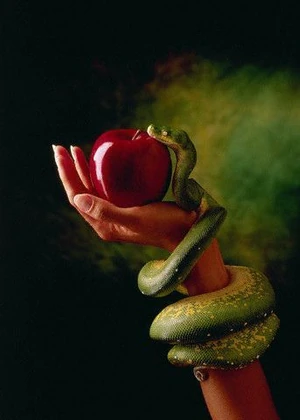
Forbidden Fruit
The Forbidden Fruit (often envisioned as an apple) was a divine fruit in Judeo-Christian traditions that became a tool of evil when the Serpent (though other believers and scholars thought and/or argued this creature is the disguise of either The Devil or Lilith) successfully tempted Eve into eating it, which was a grave sin as the Forbidden Fruit (true to its name) was the sole fruit in all of Eden that God forbade humanity from eating.
Eve in turn tempted Adam into trying the Forbidden Fruit and at once the two of them became aware of their nakedness and tried to hide themselves out of shame, when God came to visit them they became afraid and tried to hide.
Yet God found them and thus, this began the event known as the Fall of Man. It is said the tree (the Tree of Knowledge of Good and Evil) that bore the Forbidden Fruit still exists in the Garden of Eden but God has sent a powerful angel to guard the gates of Eden so that no mortal may enter it, as was part of his punishment for Adam and Eve's transgression.
The Forbidden Fruit is often identified as an apple in Christianity's holy text known as the Bible. But according to the Qur'an and in Islamic stories, the fruit was a banana.
In recent years, some researchers are supporting the fact that the Forbidden Fruit is actually a pomegranate, a fruit also mentioned in the tragic myth of the Greek goddess Persephone, from the supposed location of the Garden of Eden. Most scholars have said that the type of fruit is not forbidden, only the fruit from the tree God had warned about.
The pomegranate (Punica granatum) is a fruit-bearing deciduous shrub or small tree growing to between 5 and 8 meters tall.
The pomegranate originated in Persia and has been cultivated in Georgia, Armenia and the Mediterranean region which are filled with pomegranate trees (not apple trees).
in Armenia (where pomegranates are mostly consumed), the pomegranate represents an everlasting life.
